Seabird Transfer of Nutrients and Trace Elements from the North Water Polynya to Land during the Mid-Holocene Warm Period, Carey Islands, Northwest Greenland + Supplementary Appendix Figure S1 (See Article Tools)
DOI:
https://doi.org/10.14430/arctic4577Keywords:
mercury, cadmium, seabirds, guano, peat, North Water polynya, Holocene, Thermal MaximumAbstract
Seabird guano from large nesting colonies is known to increase trace metal levels in adjacent terrestrial environments today, when global oceans are contaminated with Hg, Cd, and other metals. But the effect of seabird guano in the pre-industrial period has rarely been studied. We used stable C and N isotopic and trace element analyses of a peat core that represents ca. 2000 years of organic matter accumulation to examine the effect on trace elements and nutrients of a seabird colony that existed in northern Baffin Bay during the Holocene Thermal Maximum (ca. 8000–5000 yr BP). Although C and N concentrations were typical of those in other peats, isotopic data identified marine organic matter as the main source of N and a minor source of C in the peat and showed that the unknown seabird was a fish-eating species that was summer-resident for the 2000 yr period. Concentrations of Cd, Br, Sr, and Zn in peat were up to an order of magnitude higher than in ombrotrophic (air-fed) bogs elsewhere, whereas Hg and Cu concentrations were similar to those in other peats, suggesting relatively low levels of Hg and Cu in the guano. This surprising result for Hg contrasts with studies on modern seabirds, in which guano markedly increased environmental Hg concentrations. It could be a consequence of Hg concentrations in Arctic marine food webs in the pre-industrial period that were an order of magnitude lower than those of today.


